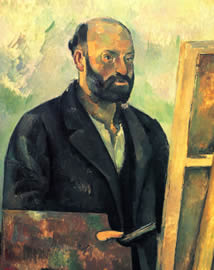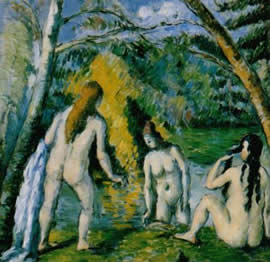
arts
Cezanne, Synergy, Stumble
In 1910, Max Weber walked into Alfred Stieglitz gallery 291 in New York carrying several black-and-white photographs of a recent exhibit he had attended in Paris. Stripped of the intense color and the layering of texture for which Cezanne is so well known, the composition alone was enough to influence the burgeoning American modern movement in both painting and photography. Apples and peaches attain a monumental stature in a world where geometry and physics are slightly askew. Nude bathers with their blurred outlines erase the clear demarcation between human and nature. The strong forms of the landscape in a flattened world press the mountains ever forward. Stieglitz himself, as well as fellow photographers Paul Strand and Edward Steichen, were equally ignited by their exposure to Cezanne.
Cezanne and American Modernism is the first exhibition to explore the indirect relationship between the French master and 34 American artists, none of whom met him. The western artist, Willard Nash, never even saw a Cezanne original. They were all, however, aware of his work, whether it was Morgan Russell seeing “Five Apples” at Gertrude Stein’s salon or Marsden Hartley becoming engrossed in a published monograph of the paintings. Matisse made a point of emphasizing Cezanne in his studio, where Andrew Dasburg and Max Weber absorbed those visions and made them their own, not by imitation but by reinventing the ideas embodied in the work. The synergy between these painters is striking. Sometimes working together or by sharing work, one painting the other’s portrait or responding in direct homage to a work of Cezanne, these painters found new ways to process the concepts they had internalized. You need only look at Stieglitz’s portrait of Hartley and then at Hartley’s “Mont Sainte Victoire” to see how Cezanne’s influence connected both artist and the artistic subject.
Synergy: these painters and photographers are prime examples.  So, where are those synergies today? Perhaps they’re occurring in a photography studio in India or an artist collective in China. But, it’s equally likely they’ll be found in the virtual world, where visionary artists can reach out with a million hits, never knowing which one connects. Curious to see where some of those connections may be generated or simply want to channel surf the web in a fresh way? Try www.stumbleupon.com. This search engine sorts through the morass of websites and youtube, using your preferences (you vote up or down on sites presented), to bring you innovative ideas in art, music, culture, travel, and a variety of other topics. Start just by checking “art” and see what you get. You may not turn up any masterful work, but the sheer whimsy and sparkle of creativity could get your own creative juices flowing.
So, where are those synergies today? Perhaps they’re occurring in a photography studio in India or an artist collective in China. But, it’s equally likely they’ll be found in the virtual world, where visionary artists can reach out with a million hits, never knowing which one connects. Curious to see where some of those connections may be generated or simply want to channel surf the web in a fresh way? Try www.stumbleupon.com. This search engine sorts through the morass of websites and youtube, using your preferences (you vote up or down on sites presented), to bring you innovative ideas in art, music, culture, travel, and a variety of other topics. Start just by checking “art” and see what you get. You may not turn up any masterful work, but the sheer whimsy and sparkle of creativity could get your own creative juices flowing.
Beginning at New Jersey’s Montclair Art Museum, “Cezanne and American Modernism” is now appearing at the Baltimore Museum of Art through May 23, 2010, and will finish at the Phoenix Art Museum July 3, 2010 – September 26, 2010.
Kate Coffey lives in Baltimore but still manages to travel through time and space using only her imagination and a lot of Frequent Traveler miles.
© 2006-2013 ConceptDesign, Inc. Terms of Use
BoomSpeak - For babyboomers - by babyboomers.